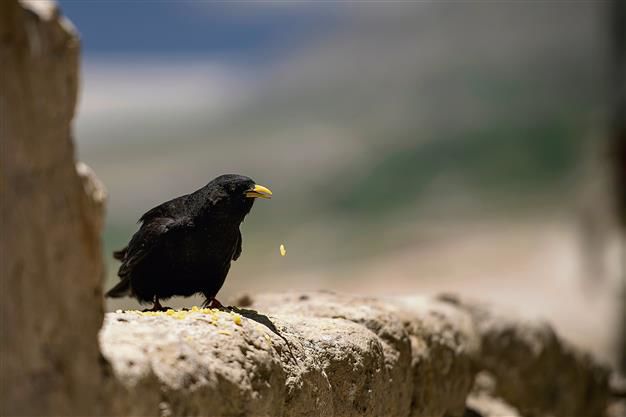The unfathomed wonderland that is Zanskar
We four childhood friends, classmates since 1972, journeyed through Ladakh and returned via Zanskar last fortnight. Zanskar in Tibetan means the ‘land of white copper’ and the accounts we read or heard were indeed alluring. So, we decided to traverse the region — my three friends in an SUV and I on my motorcycle. At the end of two weeks, it did turn out to be an unfathomed wonderland, be it the landscapes, the cultural milieu or the flora and fauna.
Zanskar falls in Kargil district of the UT of Ladakh. It is sandwiched between the Great Himalayan ranges to its south-west and Zanskar range to its north-east. Since it falls in the rain shadow region of Great Himalayas, it is a high-altitude cold desert. The altitude of Zanskar varies between 3500m and 6000m above the mean sea level
We entered the region from Suru valley and realised that the roads ran between the tree line (3000m) and the snow line (4000m). The slopes of the towering mountains were bare, brown and weathered or covered in snow. As soon as we rode over Pensi La, the gateway to Zanskar, we were welcomed by a flock of bharal (blue sheep), which charged up the ravine but offered us a wonderful sighting. I walked to the road berm which abutted a glacial outwash. It was covered with small plants bearing bright yellow flowers. Suddenly, two Himalayan marmots, all fat and cuddly, lumbered up to the edge and stood up on their hind legs in the typical rodent fashion, quite unafraid. Perhaps, people were feeding them or the gentle locals left them alone, thus prompting them to lead fearless lives! I shooed them away, because these unsuspecting souls become road-kill victims when they start trusting people and keep walking up to the roads.
They ran into their burrow screaming and whistling their alarm calls. I sat down on the road berm and soon the marmots started appearing from there burrows. I counted 16 of them and the entire outwash seemed to be a warren of marmot burrows. They regaled me with their antics and all of a sudden, there was some more whistling and shrieking while they all vanished into their subterranean safe houses. I had not moved, what was it that set off the alarm? A shadow moved and when I looked up, a golden eagle was soaring on its 2-metre wingspan, looking for its breakfast. It was a glorious sight. The first step into the valley was so eventful.
As we descended from the pass, we entered the breeding grounds of the migratory birds seen in winter in the plains. There were Eurasian Magpies, Hill Pigeons, White-winged Redstarts, Blue Throats, Red-billed and Yellow-billed Choughs, Chukar Partridges, flocks of House Sparrows, Mountain Finches and Rose Finches near every village or field.
At the Rangdum Dak Bungalow, where we spent the night, a pair of Hill Pigeons was nesting on the windowsill and a flock of Asian House Martins under the ewes of an adjoining house. Across the road, on the sand bars of Stod river, I saw for the first time a nesting sight of Ruddy Shell Ducks.
At Sani lake, which is a kettle lake formed by glacial action, there were a pair of Whiskered Terns nesting on a dry mound in the water. I also saw that the lake was a breeding ground for the indigenous Snow Trout. There were many other birds like Citrine Wagtails, White Wagtails, Grey Wagtails, Wood Sandpipers — that migrate to plains in winters.
Just outside the Sani monastery, in a mustard field, I saw large flocks of House Sparrows, Great Rose Finches, Common Rose Finches, Fire-fronted Serins and Brandt’s Rose Finches, feeding peacefully.
We spent a couple of days in Padum, visiting the monasteries and other places of interest. At Karsha monastery, someone rang the gong and the monks and novices lined up for lunch. As soon as the gong rang, a large number of Yellow-billed Choughs appeared literally out of thin air and sat on the parapets, waiting till the monks shared their rice with the crows.
From Padum, we rode over dirt tracks and non-existent roads to Purne. Since the ride was very taxing, we decided to spend the night in Dolma camps, an assortment of cottages, tents and camping space arranged in a semi-circle with the owner’s fields in the middle. Early morning, I was greeted by a covey of Chukar Partridges and a flock of Hill Pigeons feeding in the wheat and pea fields, but they took flight when they saw me and settled on the slope above. Moments later, I heard alarm calls of the Chukar. On investigating, I saw a Red Fox stalking the Chukars, but fled when more people gathered. We moved off around 7 am from Purne on our last day in Zanskar and headed for Shinku La. Just short of Gonbo Rongjon, the ‘God’s Mountain’, I saw four Ibex on the mountain slope, their horns curving back majestically. A few Lammergeiers and Himalayan Griffons were circling lazily, floating on rising thermals as the sun heated the land below.
— The writer is former president of the Chandigarh Bird Club









